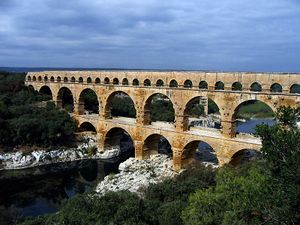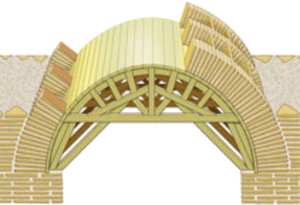Arch Bridges
From DT Online
We may not know who first constructed an arch but Romans certainly became expert at building stone arch bridges across rivers. The fact that some still stand today is proof that the arch works! . . . and of course, a dome can be thought of as an arch which has been rotated around its central vertical axis.
Stone arches are built on a shaped timber framework called the centring or falsework. The tapered stones which make up the arch are called voussoirs and the arch will only hold together once the final voussoir, the keystone at the crown of the arch, is in position. The centring can then be removed, or 'struck', by easing down the timber from the stonework.
This must be done carefully because one side of the centring is released faster than the other, the stonework can sway over and collapse!
Spandrels are the spaces between arches or at each end of a single arch These are filled with rubble and soil so roadways can be laid on top. The full weight of the stone arch, and anything crossing over it, is transferred down to the ground along the slim line of the voussoirs beneath. Arches are well-suited to materials such as masonry and brick which are strong in compression but weak in tension.
The large compressive forces in the voussoirs have to be resisted by large horizontal forces at the abutments. This is easy on rock but in the typical soils of a river valley, massive foundations are required to resist them.
In some arches, the ends are joined by wrought iron rods to prevent them spreading and this is also a method used for repair or reinforcement.
As materials such as steel and reinforced concrete became more commonly used, bridges were designed to have such a connection - often in the form of a deck. These are known as tied-arches or bowstring arches.


